By Jana Igunma
Henry Ginsburg Curator for Thai, Lao, and Cambodian Collections
London, British Library
The entire illustrated manuscript described in this article is available for viewing in Rollins College Archives Digital Collections: Phra Malai Manuscript Khom Script
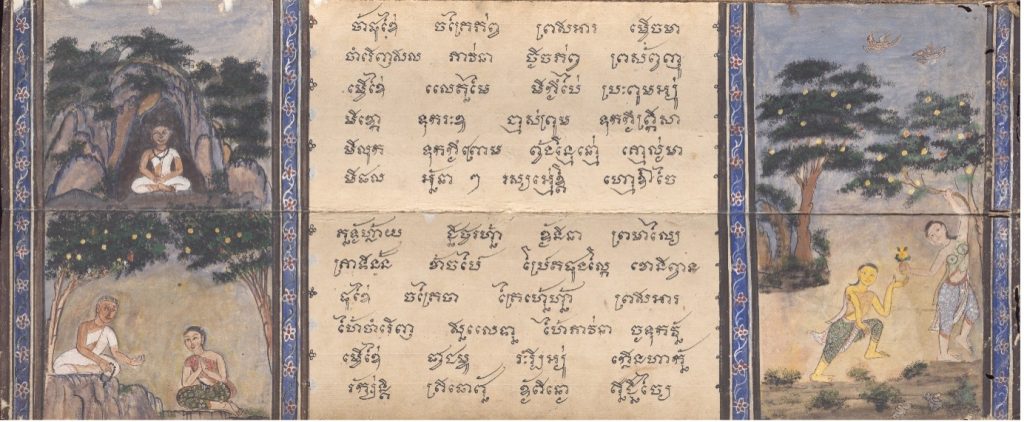
The paired illustrations on this folio reflect upon a story within the legend of Phra Malai. When the monk Phra Malai travelled to the Buddhist heavens, he learned about the future of mankind. When the age of the current Buddha Gotama comes to an end (5000 years after the Buddha’s enlightenment), humans will destroy each other, except those who hide in caves in meditation. Once the future Buddha Metteyya arrives, the surviving peaceful humans will enjoy blissful lives in a world with wish-fulfilling trees. 1
This manuscript from the collection of Henry Harkness is a folding book, or leporello book, which was made from naturally cream-coloured mulberry bark paper in Thailand (formerly Siam). It contains two Buddhist blessing chants Cullajayamaṅgala and Mahājaya, both belonging to the Mahādibbamanta corpus. 1 These texts, popular for chanting until the mid-19th century, are in Pali language and were written with black ink in Khmer script. The main text, however, is a longer text with the title Phra Malai Klon Suat (Chanted Poem of the monk Phra Malai). This text is in Thai language written in Khom script which is a version of Khmer script used exclusively to write Thai texts.
The folding book contains eleven folios with paired paintings depicting Hindu-Buddhist deities and scenes from the story of the monk Phra Malai, and one larger painting of the Buddhist heavens covering a full folio. The text tells about the monk-saint Phra Malai who, thanks to accumulated merits and advanced meditation skills, was able to travel between the Buddhist realms of heavens, hells, and the human world. The poetic version was traditionally recited during funeral wakes and other important occasions. The illustrations are in the painting style of the Rattanakosin era, with some Chinese and European influences that became popular during the reigns of Rama III (1824-51) and Rama IV (1851-68). The manuscript does not contain a colophon or date, but the provenance of the manuscript and the presence of the Siamese flag (used on trade and war ships before it became the national flag in 1840) in one of the illustrations depicting a white elephant on red background indicate that the manuscript may have been created between 1826-38.
Phra Malai manuscripts were often commissioned during the nineteenth century on occasion of a funeral or commemoration service, or sometimes by elderly people nearing the end of their lives or someone with an incurable illness. The story of the monk Phra Malai conveys essential teachings of the Buddha on Karma (Pali: kamma), Nirvana (Pali: nibbana), the Buddhist cosmos and moral principles. Creating and donating such manuscripts was regarded as a way to disseminate Buddhist wisdom, and therefore an act of merit central to everyday Buddhist practice.
[Note: The author wishes to thank Dr. Trent Walker for identifying the Pali texts included in this manuscript.]
Buddhism Illustrations
On the left is the god Indra (also known as Sakka, Lord of the Tavatimsa heavenly realm) with green colour of skin, seated in a respectful pose (Thai: wai) on a pedestal decorated with a Thai-style textile. On the right is the god Brahma (creator god in Hinduism/Brahmanism but integrated and worshipped in Thai Buddhism) with four faces, seated in a respectful post on a pedestal with a Thai-style textile. Both gods are facing a passage of Pali Buddhist text written in gold ink in the middle of the folio, as an expression of their respect for the Buddha’s teachings. In Thai Buddhist folklore, it is said that the gods invited the Buddha to teach the Dhamma to humans.
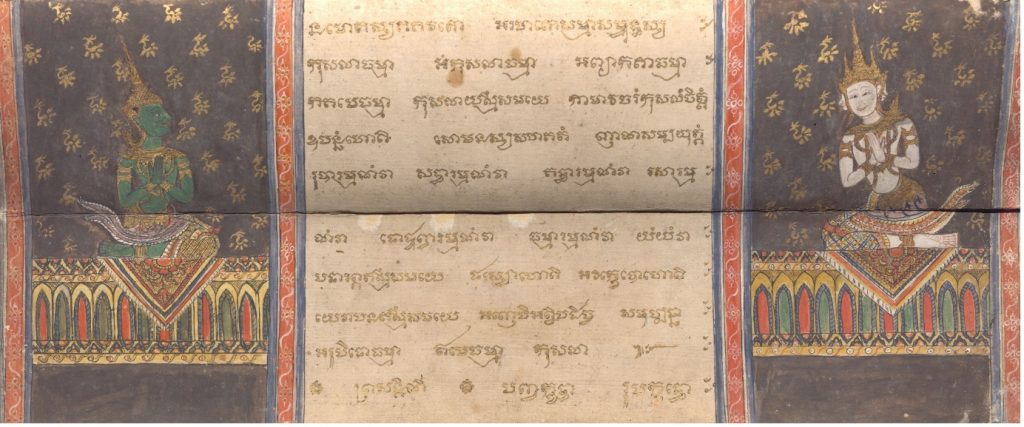
Two deities (Pali: devatā) from God Indra’s Tavatimsa heaven, seated in a respectful pose on pedestals decorated with Thai-style textiles. They are wearing several layers of Thai-style loin cloths, jewelery and crowns. Both deities are facing a passage of Pali Buddhist text written in black ink, as an expression of their respect for the Buddha’s teachings. The colours of their skin may have been an individual choice of the painter.
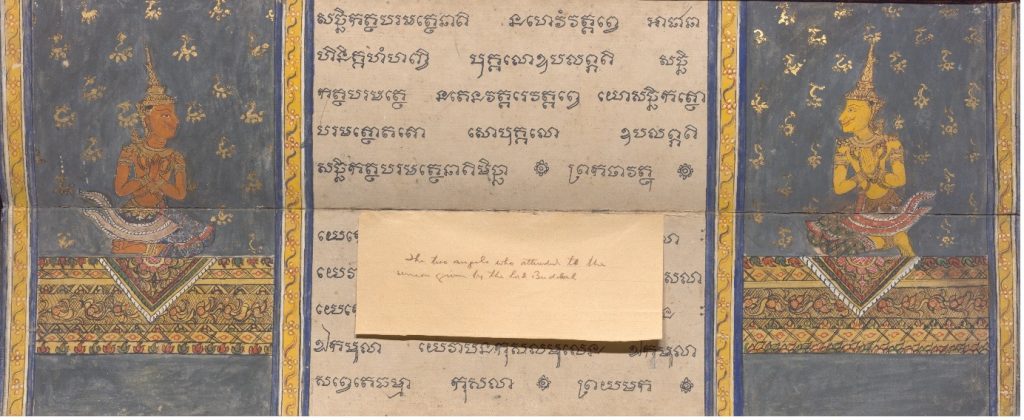
Two deities (Pali: devatā) from God Indra’s Tavatimsa heaven, seated in a respectful pose on pedestals decorated with Thai-style textiles. They are wearing several layers of Thai-style loin cloths, jewelery and crowns. Both deities are facing a passage of Pali Buddhist text written in black ink, as an expression of their respect for the Buddha’s teachings. The colours their skin appears may have been an individual choice of the painter.
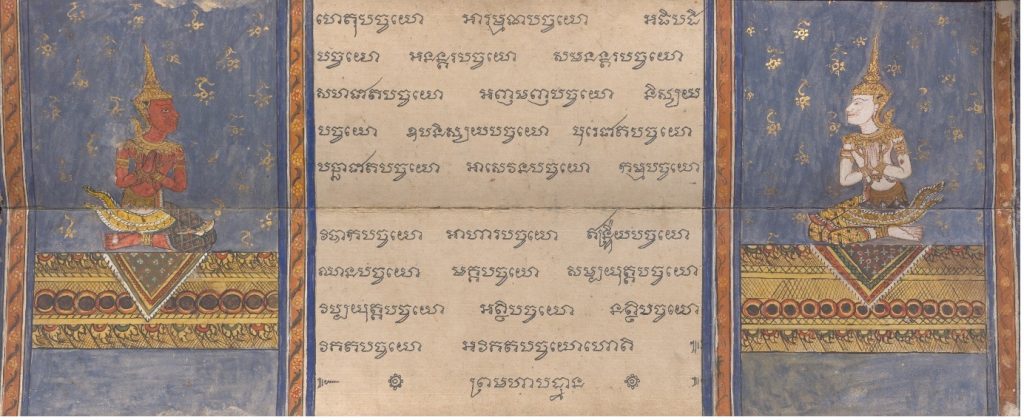
Two illustrations of hell scenes from the legend of the monk-saint Phra Malai. On the left side, those who were reborn in the hell realm (Pali: naraka) as a result of negative Karma are tormented by hell guards. On the right, hungry ghosts (Pali: preta) are begging the monk Phra Malai (above) to tell their relatives in the human realm to make merit on their behalf to ease their suffering.
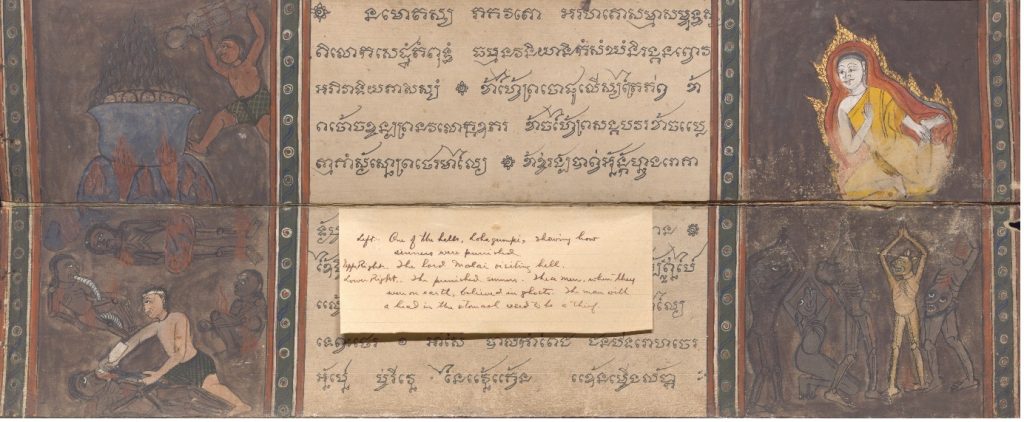
Two illustrations of the “lotus plucking scene” from the legend of Phra Malai. On the left side, a poor man is standing in a pond plucking eight lotus flowers (eight referring to the Noble Eightfold Path). On the right, the man gives the lotus flowers to Phra Malai as an offering to make merit on behalf of his deceased relatives.
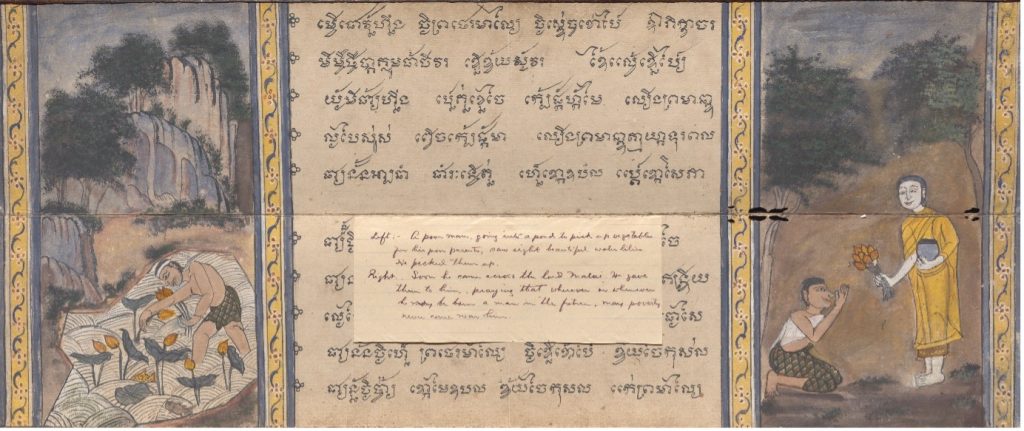
Two illustrations depicting Phra Malai’s visit to God Indra’s Tavatimsa heaven. On the left, the monk is seen in a respectful pose (Thai: wai) in front of the heavenly Chulamani Chedi that is believed to contain hair and tooth relics of the Buddha. The monk is facing a Chinese-style altar table with the lotus flower offering of a poor man, Chinese porcelain vessels and incense sticks. On the right, the monk is conversing with the God Indra.
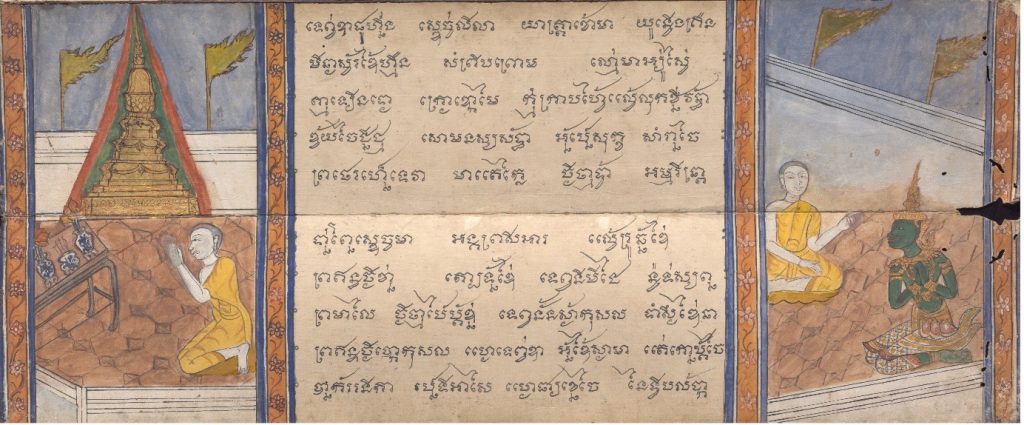
A large illustration from the legend of Phra Malai, covering a full folio with a depiction of the heavenly realm called Tusita where the future Buddha resides as a deity (Pali: devata) until he will be reborn in the human world as Buddha Metteyya. He is shown in the top right corner in a red aura with gilded edges. He is accompanied by other deities, all dressed in Thai-style outfits and crowns.
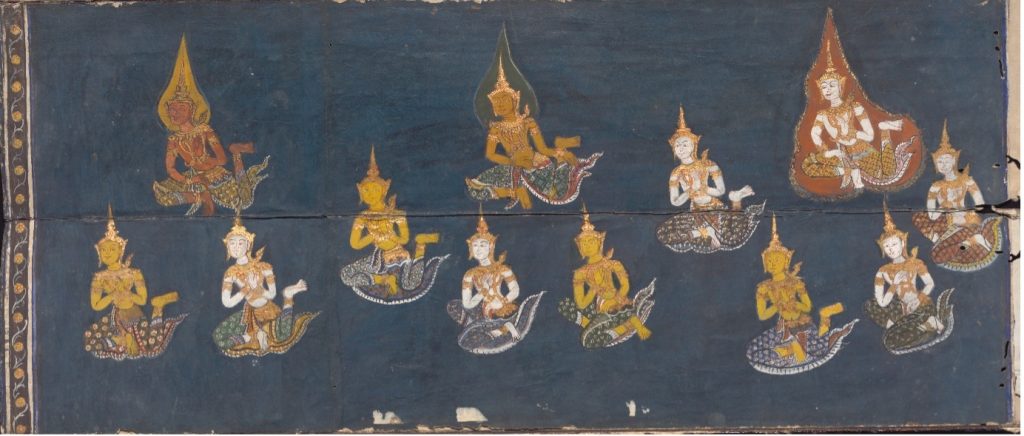
This pair of illustrations from the legend of Phra Malai depict a scene from the heavenly realm. On the left side, four deities bearing triangular flags are hovering in the air. Two of the flags (top) show white elephants on red background, resembling the Siamese flag that was introduced during the reign of Rama III (1824-51) and became the national flag around 1840. The other two flags depict gold dragons on red background. The main figure on the rights side is the Buddha Metteyya with a yellow aura, accompanied by four deities. The skin colours of the deities appear to be an individual choice of the painter.
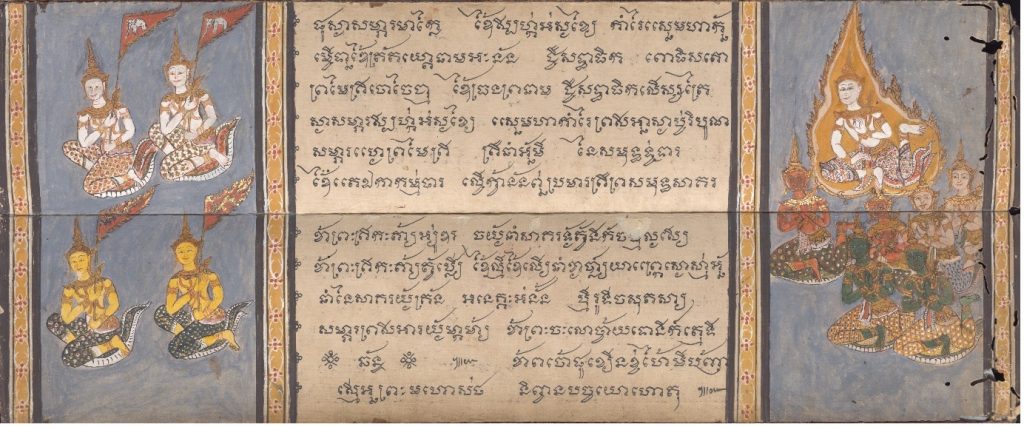
This pair of illustrations depict a scene from the story of Phra Malai. On the left, the monk is sitting in a pose resembling the Buddha’s earth-touching mudra (but with the left instead of the right hand) which represents the moment of the Buddha’s enlightenment. Phra Malai is surrounded by lay people, male on the left side, female on the right, while he is revealing what he learned during his visits to the Buddhist heavens and hells. 2
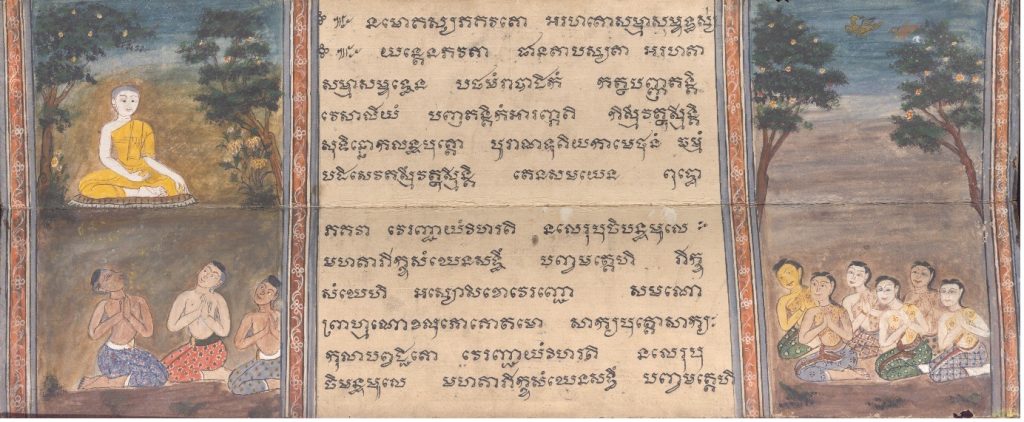
Two deities (Pali: devatā) from God Indra’s Tavatimsa heaven, seated in a respectful pose on pedestals decorated with textiles. They are wearing several layers of Thai-style loin cloths, jewelery and crowns. Both deities are facing a passage of Pali Buddhist text written in black ink, as an expression of their respect for the Buddha’s teachings.
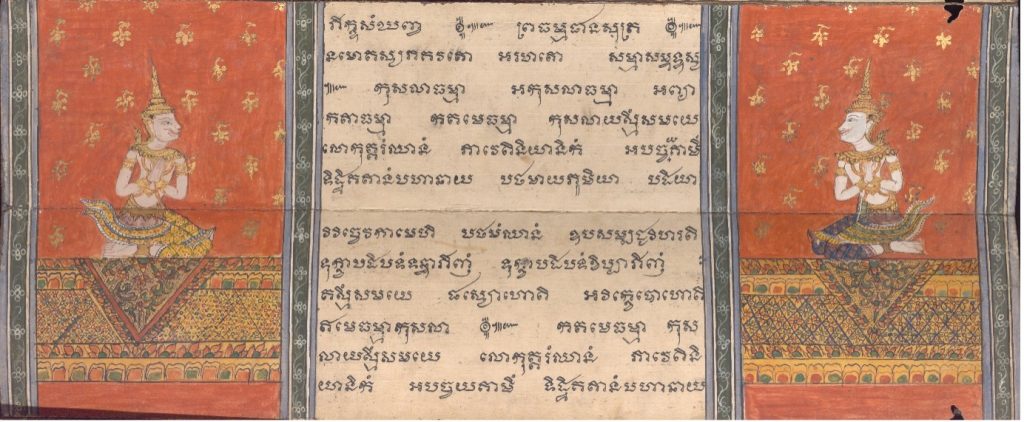
Two ogre-like deities (Pali: yakkha, Sanskrit: yaksha) from a realm between the human world and the Buddhist heavens are seated in a respectful pose on pedestals decorated with textiles. They are wearing several layers of Thai-style loin cloths, jewelery and crowns. They are facing a passage of Pali Buddhist text written in black ink, as an expression of their respect for the Buddha’s teachings.

Image Footnotes:
- In most Phra Malai manuscripts, this pair of illustrations consist of one bloody scene showing humans killing each other, while the other depicts the blissful future. The painter here chose to emphasize the blissful future, which is an interesting choice that departs from the typical Thai/Siamese tradition of including a violent scene. ↩︎
- The apparent gender separation of the audience is not typical for Thai Phra Malai manuscripts. ↩︎
Further Reading
Brereton, Bonnie Pacala: Thai Tellings of Phra Malai – Texts and Rituals Concerning a Buddhist Saint. Tempe, Arizona: Arizona State University, 1995 (includes a translation of the story).
Igunma, Jana: A Buddhist Monk’s Journeys to Heaven and Hell. The Journal of International Association of Buddhist Universities (JIABU) 6:1, 2013, 65–82, https://so06.tci-thaijo.org/index.php/Jiabu/article/view/217855.
Igunma, Jana: A Thai book of merit: Phra Malai’s journeys to heaven and hell. British Library Asian and African Studies Blog, 29 September 2013.
